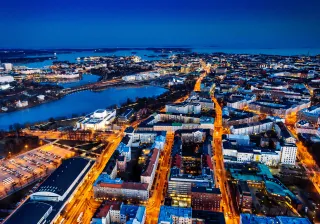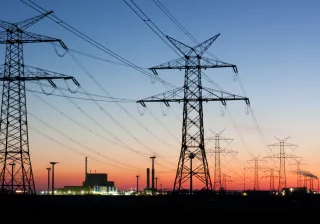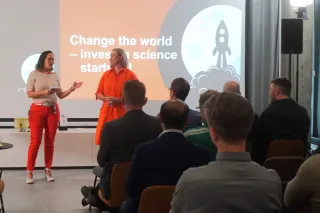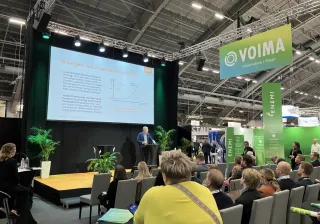In December, a significant milestone was reached in the commissioning of Finland's fifth nuclear power plant when the Olkiluoto 3 reactor started for the first time. The commissioning programme has now taken another step forward. The plant's generator was synchronised to the national power grid on 12 March. This means that power from OL3 is finally flowing into the outlets in our homes. The test phase will continue until the end of July, after which the plant will switch to commercial production.
I myself have been following the progress of the project throughout my whole professional career. I got my Master’s degree in the spring of 2002, when the new nuclear power plant was also given the green light by the Finnish Parliament. After the initial phase, however, the project did not proceed as planned, and the construction was eventually delayed by almost 13 years. Olkiluoto 3 has also been named as the most expensive building in the world. The price tag, however, includes much more than just the concrete amounting to the size of five Finnish Parliament Buildings. What kind of nuclear power plant is Finland finally getting after a long wait, and what role will nuclear power play in the forthcoming energy transition?
Will small reactors displace large nuclear power plants?
The EPR (European Pressurized Water Reactor) constructed at the Olkiluoto site is a relatively conventional nuclear power plant. The reactor, its cooling cycle and turbine represent traditional pressurised water technology, which has been in worldwide use since the 1960s. New technology is mainly found in the plant's safety systems. Like other third-generation nuclear power plants, the safety design of the EPR takes advantage of the decades of practical experience. This is reflected, for example, in the management of severe accidents.
When the reactor was ordered at the beginning of the millennium, nuclear power plants were still mainly designed for centralised power generation. At that time, large unit size was considered a major commercial advantage. The EPR was, and still is, the largest reactor on the market. The development of new reactor technology has since then been focused on small modular reactors (SMRs) with reduced unit size and simpler design. Instead of the economy of scale, competitiveness is sought from serial production. An SMR power plant may consist of multiple smaller independent reactor modules. Small unit size is also better suited for the combined production of heat and power, and the amount of capital tied to long-term investments may be significantly reduced. This technology is still waiting for the commercial breakthrough, but news on the development of various SMR concepts are reported on a weekly basis.
There is still market for traditional large nuclear power plants, though. When the demand for low-carbon electricity is high, the construction of large production units is also an attractive solution. During the Olkiluoto 3 project, more than 40 new nuclear power plants have been commissioned in China, most of which are large units producing more than 1,000 megawatts of power. In Poland, the government energy strategy includes a plan to build six large light water reactors over the next few decades, with a total capacity of 6,000 to 9,000 megawatts.
In many countries relying on nuclear power, new reactors have started to replace old units. In the UK, for example, new capacity is needed to replace gas-cooled AGR reactors which are at the end of their lifespan. Two EPR power plant units are currently being built at the Hinkley Point site. In the country's latest energy strategy, the construction of additional nuclear power capacity has been given a significant role. In the Netherlands, a similar political decision was recently taken to resume the construction of nuclear power plants after a long hiatus.
Finland's greatest climate act?
Teollisuuden Voima has named Olkiluoto 3 the greatest climate act in Finland. Is this just an advertising slogan, or does the commissioning of a new nuclear power plant really bring as significant benefits as the claim suggests? Nuclear power is one of the low-carbon technologies available for electricity production, but how large a contribution can a single reactor make?
In 2021, the total domestic electricity production amounted to 69 Twh. Production shares were divided between nuclear power (22.7 TWh), hydroelectric (15.5 TWh), biomass (13.5 TWh), wind power (8.1 TWh) and fossil fuels (8.1 TWh) and other energy sources. The Olkiluoto 3 plant is estimated to produce 12-13 TWh of electricity per year, which means an increase by more than a half in nuclear energy production, or almost 20% increase in total electricity production. Nuclear power has been the most significant single source of electricity in Finland for some time now, and the commissioning of the new plant will increase the share of nuclear power to more than 40%. The commissioning of Olkiluoto 3 will also reduce dependence on imported electricity, which has major implications for energy self-sufficiency and security of supply. Nuclear fuel can be stored on site, and the supply chain is not critically dependent on a single vendor.
The commissioning of Olkiluoto 3 will also reduce dependence on imported electricity.
Nuclear energy is often criticised as being too slow a means to make any significant contribution to global greenhouse gas emission reductions. However, such claims are based more on various future scenarios than on actual production. Concerns about the slow pace of nuclear power construction reflect more the fact that fossil fuels are not being replaced by any low-carbon energy source fast enough. The previous figures show that the production from OL3 alone exceeds the total annual production of all wind turbines in Finland in 2021. The fact that a nuclear power plant that is completed 13 years behind schedule overtakes wind power does not paint a flattering picture of the construction pace of renewable energy sources either.
Even though the Olkiluoto EPR is used in many contexts as the poster child of all problems related to nuclear power construction, statistics suggest that this is more of an exception than a rule. During the project, more than 50 new nuclear power plant projects around the world have been successfully completed in a much shorter time frame. Most of the plants have been built in China, where the average construction time has been reduced to six years. The pace of nuclear power construction is not slowing down either. According to the most recent plans, China is planning to build 150 new reactors over the next 15 years.
How to proceed from here?
In Finland, low-carbon sources cover more than 80% of domestic electricity production, which means that significant reductions in carbon emissions can no longer be achieved by investing in more clean production alone. However, the question of building more nuclear power plants will most likely be brought to public discussion sooner or later. The reason for this is the fundamental restructuring of the entire energy sector. Coal, which is still widely used for the co-generation of heat and power, will be phased out by the end of the decade. The transition to electric vehicles within the transportation sector will shift the share of energy consumed in the form of oil-based fuels to electricity production. Even more significant changes can be anticipated from the industry, as the processes are cleaned of fossil fuels.
The reductions of carbon emissions within the energy industry therefore does not mean that the consumption of electricity would be deceasing. On the contrary, new applications are expected to increase the demand of low-carbon electricity. The use of nuclear energy is also being expanded beyond conventional electricity production. In the case of Finland, one of the most interesting future applications is district heating, which is still heavily relying on fossil fuels. VTT is currently developing a low-temperature reactor specifically designed for this purpose.
When aiming for global emission reductions, the focus should be turned to hydrogen, which offers alternatives to fossil fuels used in particular in steel manufacturing and transportation. However, the transition to a large-scale hydrogen economy would require a revolution within the energy sector. In the most ambitious scenarios, low-carbon hydrogen production capacity should be increased by a factor of thousand during the next few decades. This is not a minor challenge by any means, as low-emission energy is also needed to replace fossil-based electricity production.
Future energy needs will also have an impact on the development of nuclear technology. The OL3 reactor is designed to remain in use for at least 60 years. The demand for electricity is not likely to go away, but, when the plant reaches the end of its life, the bulk of the world’s reactor fleet may consist of next-generation reactor types, such as high-temperature gas-cooled reactors, providing a steady supply of low-carbon hydrogen to industrial complexes. In China, the first high-temperature HTR-PM demonstration plant started operation last December, around the same time as the chain reaction was started for the first time in Olkiluoto 3.
The world changed on February 24, 2022
Russia’s invasion to Ukraine brought war to Europe, and changed the security status of the entire continent. In several countries, energy production and near-term climate solutions have until now relied on natural gas as a cleaner alternative to coal. Earlier this year, natural gas was labelled as a sustainable transitional fuel in the EU taxonomy. The risks taken in energy politics have now been realised in the worst possible way, and the connection between energy supply and national security can no longer be denied.
Energy self-sufficiency and security of supply also require a high level of technical competence to maintain domestic production during difficult times.
The challenges are not limited to material flows either. Energy self-sufficiency and security of supply also require a high level of technical competence to maintain domestic production during difficult times. The effects of the war in Ukraine will be reflected to the entire energy sector, including the role of nuclear power as part of the future energy solutions.
Photo of Olkiluoto 3: TVO







